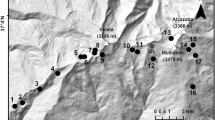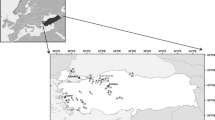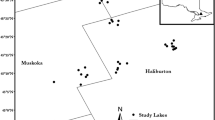Abstract
We investigated the role of trophic state in structuring the cladoceran assemblages in 35 relatively deep lakes of low nutrient levels in Southern Norway. The lakes cover gradients of altitude, latitude, longitude, area and total phosphorus concentration. The environmental control of the cladoceran assemblages was analyzed using canonical correspondence analysis. Total phosphorus was the most important variable in the minimal adequate model. Hence, the cladoceran assemblage changed with trophic state. Typical clear water species were displaced by indicators of eutrofication with increasing trophic levels. Littoral species constituted the majority of the species recorded. Littoral and pelagic species richness showed a unimodal relationship with trophic state. Along with the change in trophic state and shift in cladoceran assemblage, we observed an increase in the ratio of pelagic to littoral species as well as in the ratio of pelagic efficient bacterial feeders to total pelagic filter feeders. The study indicates that zooplankton could provide a valuable indicator of ecosystem’s structure and function in deeper nutrient poor lakes if included in water quality assessments according to the EU Water Framework Directive. Including sampling of the littoral zooplankton would improve diversity estimates and incorporate the response of the littoral zone to eutrophication.





Similar content being viewed by others
References
Barnett, A. & B. E. Beisner, 2007. Zooplankton biodiversity and lake trophic state: explanations invoking resource abundance and distribution. Ecology 88: 1675–1686.
Barnett, A. J., K. Finlay & B. E. Beisner, 2007. Functional diversity of crustacean zooplankton communities: towards a trait-based classification. Freshwater Biology 52: 796–813.
Bern, L., 1990. Size-related discrimination of nutritive and inert particles by freshwater zooplankton. Journal of Plankton Research 12: 1059–1067.
Bern, L., 1994. Particle selection over a broad size range by crustacean zooplankton. Freshwater Biology 32: 105–112.
Berzins, B. & J. Bertilsson, 1989. On limnitic micro-crustaceans and trophic degree. Hydrobiologia 185: 95–100.
Berzins, B. & B. Pejler, 1989. Rotifer occurrence and trophic degree. Hydrobiologia 182: 171–180.
Bird, D. F. & J. Kalff, 1984. Empirical relationships between bacterial abundance and chlorophyll concentration in fresh and marine waters. Canadian Journal of Fisheries and Aquatic Sciences 41: 1015–1023.
Bjerring, R., E. Becares, S. Declerck, E. M. Gross, L. A. Hansson, T. Kairesalo, M. Nykanen, A. Halkiewicz, R. Kornijow, J. M. Conde-Porcuna, M. Seferlis, T. Noges, B. Moss, S. L. Amsinck, B. V. Odgaard & E. Jeppesen, 2009. Subfossil cladocera in relation to contemporary environmental variables in 54 Pan-European lakes. Freshwater Biology 54: 2401–2417.
Brendelberger, H. & W. Geller, 1985. Variability of filter structures in eight Daphnia species: mesh sizes and filtering areas. Journal of Plankton Research 7: 473–486.
Brodersen, K. P., M. C. Whiteside & C. Lindegaard, 1998. Reconstruction of trophic state in Danish lakes using subfossil chydorid (Cladocera) assemblages. Canadian Journal of Fisheries and Aquatic Sciences 55: 1093–1103.
Brooks, J. L. & S. I. Dodson, 1965. Predation, body size, and composition of plankton. Science 150: 28–35.
Caroni, R. & K. Irvine, 2010. The potential of zooplankton communities for ecological assessment of lakes: redundant concept or political oversight? Biology and Environment-Proceedings of the Royal Irish Academy 110B: 35–53.
Certain, G., O. Skarpaas, J. W. Bjerke, E. Framstad, M. Lindholm, J. E. Nilsen, A. Norderhaug, E. Oug, H. C. Pedersen, A. K. Schartau, G. I. van der Meeren, I. Aslaksen, S. Engen, P. A. Garnasjordet, P. Kvaloy, M. Lillegard, N. G. Yoccoz & S. Nybo, 2011. The nature index: a general framework for synthesizing knowledge on the state of biodiversity. PLoS ONE 6: 14.
Chen, G. J., C. Dalton & D. Taylor, 2010. Cladocera as indicators of trophic state in Irish lakes. Journal of Paleolimnology 44: 465–481.
de Eyto, E., K. Irvine, F. Garcia-Criado, M. Gyllstrom, E. Jeppesen, R. Kornijow, M. R. Miracle, M. Nykanen, C. Bareiss, S. Cerbin, J. Salujoe, R. Franken, D. Stephens & B. Moss, 2003. The distribution of chydorids (Branchiopoda, Anomopoda) in European shallow lakes and its application to ecological quality monitoring. Archiv für Hydrobiologie 156: 181–202.
DeMott, W. R., 1985. Relations between filter mesh-size, feeding mode, and capture efficiency for cladocerans feeding on ultrafine particles. Archiv für Hydrobiologie Beiheft Ergebnisse der Limnologie 21: 125–134.
Dodson, S. I., S. E. Arnott & K. L. Cottingham, 2000. The relationship in lake communities between primary productivity and species richness. Ecology 81: 2662–2679.
Duigan, C. A., 1992. The ecology and distribution of the littoral freshwater Chydoridae (Branchiopoda, Anomopoda) of Ireland, with taxonomic comments on some species. Hydrobiologia 241: 1–70.
Flössner, D., 2000. Die Haplopoda und Cladocera (ohne Bosminidae) Mitteleuropas. Backhuys Publishers, Leiden.
Gannon, J. E. & R. S. Stemberger, 1978. Zooplankton (especially Crustaceans and Rotifers) as indicators of water quality. Transactions of the American Microscopical Society 97: 16–35.
Geller, W. & H. Müller, 1981. The filtration apparatus of Cladocera: filter mesh-sizes and their implications on food selectivity. Oecologia 49: 316–321.
Gliwicz, Z. M., 1977. Food size selection and seasonal succession of filter feeding zooplankton in an eutrophic lake. Ekologia Polska 25: 179–225.
Hansen, A. M., J. V. Christensen & O. Sortkajer, 1991. Effect of high pH on zooplankton and nutrients in fish-free enclosures. Archiv für Hydrobiologie 123: 143–164.
Herbst, H. V., 1976. Blattfusskrebse (Phyllopoden: Echte Blattfüsser und Wasserflöhe). Kosmos Verlag, Stuttgart.
Hessen, D. O., 1985. Filtering structures and particle size selection in coexisting Cladocera. Oecologia 66: 368–372.
Hessen, D. O., B. A. Faafeng, V. H. Smith, V. Bakkestuen & B. Walseng, 2006. Extrinsic and intrinsic controls of zooplankton diversity in lakes. Ecology 87: 433–443.
Hessen, D. O., J. P. Nilssen & T. O. Eriksen, 1986. Food size spectra and species replacement within herbivorous zooplankton. Internationale Revue gesamten Hydrobiologie 71: 1–10.
Hill, M. O. & H. G. Gauch, 1980. Detrended correspondence analysis: an improved ordination technique. Plant Ecology 43: 47–58.
Jeppesen, E., J. P. Jensen, C. Jensen, B. Faafeng, D. O. Hessen, M. Søndergaard, T. Lauridsen, P. Brettum & K. Christoffersen, 2003. The impact of nutrient state and lake depth on top-down control in the pelagic zone of lakes: a study of 466 lakes from the temperate zone to the arctic. Ecosystems 6: 313–325.
Jeppesen, E., J. P. Jensen, M. Søndergaard & T. L. Lauridsen, 2005. Response of fish and plankton to nutrient loading reduction in eight shallow Danish lakes with special emphasis on seasonal dynamics. Freshwater Biology 50: 1616–1627.
Jeppesen, E., P. Nõges, T. A. Davidson, J. Haberman, T. Nõges, K. Blank, T. L. Lauridsen, M. Søndergaard, C. Sayer, R. Laugaste, L. S. Johansson, R. Bjerring & S. L. Amsinck, 2011. Zooplankton as indicators in lakes: a scientific-based plea for including zooplankton in the ecological quality assessment of lakes according to the European Water Framework Directive (WFD). Hydrobiologia 676: 279–297.
Jeppesen, E., M. Søndergaard, J. P. Jensen, E. Mortensen, A. M. Hansen & T. Jorgensen, 1998. Cascading trophic interactions from fish to bacteria and nutrients after reduced sewage loading: an 18-year study of a shallow hypertrophic lake. Ecosystems 1: 250–267.
Karabin, A., 1985. Pelagic zooplankton (Rotatoria + Crustacea) variation in the process of lake eutrophication. I. Structural and quantitative features. Ekologia Polska 33: 567–616.
Leibold, M. A., 1999. Biodiversity and nutrient enrichment in pond plankton communities. Evolutionary Ecology Research 1: 73–95.
Liboriussen, L. & E. Jeppesen, 2006. Structure, biomass, production and depth distribution of periphyton on artificial substratum in shallow lakes with contrasting nutrient concentrations. Freshwater Biology 51: 95–109.
Lyche, A., 1990. Cluster analysis of plankton community structure in 21 lakes along a gradient of trophy. Verhandlungen des Internationalen Verein Limnologie 24: 586–591.
Nevalainen, L., K. Sarmaja-Korjonen & T. P. Luoto, 2011. Sedimentary Cladocera as indicators of past water-level changes in shallow northern lakes. Quaternary Research 75: 430–437.
NS4720, 1979. Water analysis—determination of pH. Standards Norway.
NS4725, 1984. Water analysis—determination of total phosphorus—digestion by peroxodisulphate. Standards Norway.
NS4743, 1993. Water analysis—determination of total nitrogen after oxidation by peroxodisulphate. Standards Norway.
NS-EN15110, 2006. Water quality—guidance standard for the sampling of zooplankton from standing waters. Standards Norway.
NS-EN-ISO14911, 1999. Water quality—determination of dissolved Li+, Na+, NH4+, K+, Mn2+, Ca2+, Mg2+, Sr2+ and Ba2+ using ion chromatography—method for water and waste water. Standards Norway.
NS-ISO8245, 1987. Water quality—guidelines for the determination of total organic carbon (TOC). Standards Norway.
Økland, R. H., 1990. Vegetation ecology: theory, methods and applications with reference to fennoscandia. Sommerfeltia 1(Suppl.):1–172.
Palmer, M. W., 1993. Putting things in even better order—the advantages of canonical correspondence-analysis. Ecology 74: 2215–2230.
Pejler, B., 1965. Regional-ecological studies of Swedish fresh-water zooplankton. Zoologiska bidrag från Uppsala 36: 407–515.
Pejler, B., 1983. Zooplanktic indicators of trophy and their food. Hydrobiologia 101: 111–114.
Penning, W. E., M. Mjelde, B. Dudley, S. Hellsten, J. Hanganu, A. Kolada, M. van den Berg, S. Poikane, G. Phillips, N. Willby & F. Ecke, 2008. Classifying aquatic macrophytes as indicators of eutrophication in European lakes. Aquatic Ecology 42: 237–251.
Scheffer, M. & E. H. van Nes, 2007. Shallow lakes theory revisited: various alternative regimes driven by climate, nutrients, depth and lake size. Hydrobiologia 584: 455–466.
Smirnow, N. N., 1971. Chydoridae. Fauna USSR, Crustacea 1 (2). Israel Program for Scientific Translation 1974, Jerusalem.
Soininen, J. & M. Luoto, 2012. Is catchment productivity a useful predictor of taxa richness in lake plankton communities? Ecological Applications 22: 624–633.
ter Braak, C. J. F., 1995. Ordination. In Jongman, R. H. G., C. J. F. ter Braak & O. F. R. van Tongeren (eds.), Data analysis in community and landscape ecology. Cambridge University Press, Cambridge: 1–299.
ter Braak, C. J. F. & P. Šmilauer, 2002. CANOCO Reference Manual and CanoDraw for Windows User’s Guide: Software for Canonical Community Ordination (version 4.5). Microcomputer Power, Ithaca NY, USA.
Vadeboncoeur, Y., E. Jeppesen, M. J. V. Zanden, H. H. Schierup, K. Kristoffersen & D. M. Lodge, 2003. From Greenland to green lakes: cultural eutrophication and the loss of benthic pathways in lakes. Limnology and Oceanography 48: 1408–1418.
Walseng, B. & G. Halvorsen, 2005. Littoral microcrustaceans as indices of trophy. Verhandlungen des Internationalen Verein Limnologie 29: 827–829.
Walseng, B., D. O. Hessen, G. Halvorsen & A. K. Schartau, 2006. Major contribution from littoral crustaceans to zooplankton species richness in lakes. Limnology and Oceanography 51: 2600–2606.
Walseng, B. & L. R. Karlsen, 2001. Planktonic and littoral microcrustaceans as indices of recovery in limed lakes in SE Norway. Water, Air, and Soil pollution 130: 1313–1318.
Walseng, B. & A. K. L. Schartau, 2001. Crustacean communities in Canada and Norway: comparison of species along a pH gradient. Water, Air, and Soil pollution 130: 1319–1324.
Walseng, B., N. D. Yan & A. K. Schartau, 2003. Littoral microcrustacean (Cladocera and Copepoda) indicators of acidification in Canadian Shield lakes. Ambio 32: 208–213.
Watson, S., E. McCauley & J. A. Downing, 1992. Sigmoid relationships between phosphorus, algal biomass and algal community structure. Canadian Journal of Fisheries and Aquatic Sciences 49: 2605–2610.
Acknowledgments
The study was supported by the Norwegian Institute for Nature Research and the Norwegian Directorate for Nature Management. M. Evju, E. Framstad, I. C. Myhre and three anonymous reviewers provided valuable suggestions and comments on the manuscript.
Author information
Authors and Affiliations
Corresponding author
Additional information
Guest editors: Marina Manca & Piet Spaak / Cladocera: Proceedings of the 9th International Symposium on Cladocera
Rights and permissions
About this article
Cite this article
Jensen, T.C., Dimante-Deimantovica, I., Schartau, A.K. et al. Cladocerans respond to differences in trophic state in deeper nutrient poor lakes from Southern Norway. Hydrobiologia 715, 101–112 (2013). https://doi.org/10.1007/s10750-012-1413-5
Received:
Accepted:
Published:
Issue Date:
DOI: https://doi.org/10.1007/s10750-012-1413-5




